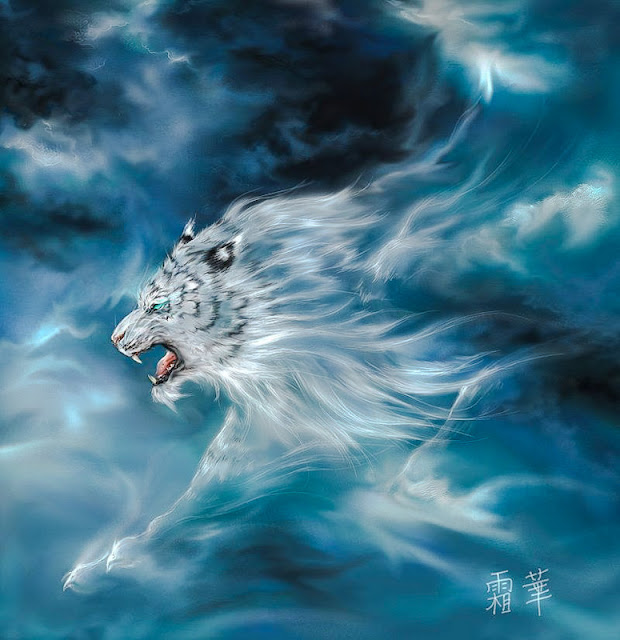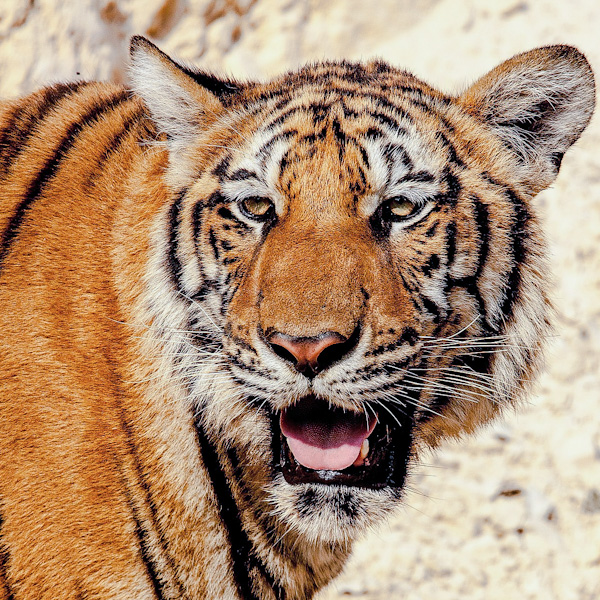About the tiger
Prepared in October 2009 - things change, which is why it is dated.
The tiger is probably the world's best known and admired wild animal. We admire its courage and strength but we fear it. Our fear has jeopardized its survival because we kill it and/or eat it. Can we change? Yes, if as a living animal we benefit sufficiently from it commercially. That would seem to be the only way for us. We cannot, it seems at present, cohabit with it.
Its appearance is dramatic to the point where we wonder how it can be beneficial in terms of camouflage. In a forest during twilight hours it is wonderfully effective.
This is an introductory page that binds various posts that I have made about the tiger, to which I have linked. It is also comprehensive in its own right.
There are about 3,200 tigers in the wild16. There are 9 subspecies of tiger1 possibly 8, three of which are extinct and the remainder are endangered. Some experts say that all tigers originate from the South China tiger5|1. However, others say that they all stem from the Siberian tiger, which migrated south and west over 100,000 years ago due to the last ice age. They established populations of tigers that evolved under the differing environments into distinctly different animals at a DNA level. Most tigers became smaller in size. The farthest west they traveled was to the Caspian Sea (to found a now extinct subspecies, the Caspian tiger, that probably never was, in fact) and as far south as the island of Bali3. From this taxonomists are able to divide the tiger into species although the classification of all species (taxonomy) is constantly under review. Click the link for the ancient history of the big cats.
It could be argued that all tigers are heading towards extinction in the wild unless things change. The future of the tiger is as a captive animal and we had better get used to it, some experts would argue.
Perhaps the species that we know best is the Bengal tiger, which lives in India, Nepal, Bhutan and Bangladesh. Then we have the Siberian tiger (Amur tiger), said to be the largest tiger. The population size of this cat is precarious but apparently stable at about 330-371 adult/sub-adult1 tigers, it is thought. But the effective population in terms of procreation is much smaller than the actual population size at about 358. I discuss this further on this site. This cat now lives primarily in Russia straddling the city of Vladivostok on the far east coastal region. The Sumatran tiger is also endangered (critically). It is a forest dweller on the island of Sumatra. The other subspecies are: South China tiger, Indochinese tiger (a part of this tiger's population has been assessed as a different species - the Malayan tiger, but this is not necessarily commonly accepted), Bali tiger ("likely" extinct in the 1940s1), Javan tiger (extinct 1970s?1), Caspian tiger (extinct).
As a subject the tiger is big and important so there are several pages on this site. It has to be.There are over four hundred thousand2 web pages on this animal on the internet at Nov. 2009. In order to get the site noticed it has to be complete. But where do we start when discussing this wild cat? We have to prioritize. In everyone of the 400 thousand pages on the internet about this wild cat there is almost certainly a description of the animal yet it is the most well known animal after the human in the world. A description is not therefore a top priority particularly when the very survival of this animal is in jeopardy in the wild.
Accordingly, the top priority is its status in the wild because it is endangered. It's survival is threatened. And we don't want to lose the tiger in the wild, which is the way things are heading. So after setting out the various subspecies referred to above, I start properly with the threats to this magnificent animal and the attempts at its conservation. Next I discuss this cat's lifestyle in some detail and that includes its ecology and behavior, its distribution and its reproduction. Oh, and finally its appearance...
Conclusion
This "home page" also includes my conclusion. But for humankind the tiger would be the world's top predator. It combines great strength with limitless courage and aggression when required. This is supported by a wide range of skills that always impress the rather feeble human. That is why we have to kill it. We fear the tiger. It fears us.
Photo by Captain Chickenpants (Flickr)
From Tiger to Wild Cat Species
The tiger is probably the world's best known and admired wild animal. We admire its courage and strength but we fear it. Our fear has jeopardized its survival because we kill it and/or eat it. Can we change? Yes, if as a living animal we benefit sufficiently from it commercially. That would seem to be the only way for us. We cannot, it seems at present, cohabit with it.
Its appearance is dramatic to the point where we wonder how it can be beneficial in terms of camouflage. In a forest during twilight hours it is wonderfully effective.
This is an introductory page that binds various posts that I have made about the tiger, to which I have linked. It is also comprehensive in its own right.
There are about 3,200 tigers in the wild16. There are 9 subspecies of tiger1 possibly 8, three of which are extinct and the remainder are endangered. Some experts say that all tigers originate from the South China tiger5|1. However, others say that they all stem from the Siberian tiger, which migrated south and west over 100,000 years ago due to the last ice age. They established populations of tigers that evolved under the differing environments into distinctly different animals at a DNA level. Most tigers became smaller in size. The farthest west they traveled was to the Caspian Sea (to found a now extinct subspecies, the Caspian tiger, that probably never was, in fact) and as far south as the island of Bali3. From this taxonomists are able to divide the tiger into species although the classification of all species (taxonomy) is constantly under review. Click the link for the ancient history of the big cats.
It could be argued that all tigers are heading towards extinction in the wild unless things change. The future of the tiger is as a captive animal and we had better get used to it, some experts would argue.
Perhaps the species that we know best is the Bengal tiger, which lives in India, Nepal, Bhutan and Bangladesh. Then we have the Siberian tiger (Amur tiger), said to be the largest tiger. The population size of this cat is precarious but apparently stable at about 330-371 adult/sub-adult1 tigers, it is thought. But the effective population in terms of procreation is much smaller than the actual population size at about 358. I discuss this further on this site. This cat now lives primarily in Russia straddling the city of Vladivostok on the far east coastal region. The Sumatran tiger is also endangered (critically). It is a forest dweller on the island of Sumatra. The other subspecies are: South China tiger, Indochinese tiger (a part of this tiger's population has been assessed as a different species - the Malayan tiger, but this is not necessarily commonly accepted), Bali tiger ("likely" extinct in the 1940s1), Javan tiger (extinct 1970s?1), Caspian tiger (extinct).
As a subject the tiger is big and important so there are several pages on this site. It has to be.There are over four hundred thousand2 web pages on this animal on the internet at Nov. 2009. In order to get the site noticed it has to be complete. But where do we start when discussing this wild cat? We have to prioritize. In everyone of the 400 thousand pages on the internet about this wild cat there is almost certainly a description of the animal yet it is the most well known animal after the human in the world. A description is not therefore a top priority particularly when the very survival of this animal is in jeopardy in the wild.
Accordingly, the top priority is its status in the wild because it is endangered. It's survival is threatened. And we don't want to lose the tiger in the wild, which is the way things are heading. So after setting out the various subspecies referred to above, I start properly with the threats to this magnificent animal and the attempts at its conservation. Next I discuss this cat's lifestyle in some detail and that includes its ecology and behavior, its distribution and its reproduction. Oh, and finally its appearance...
Conclusion
This "home page" also includes my conclusion. But for humankind the tiger would be the world's top predator. It combines great strength with limitless courage and aggression when required. This is supported by a wide range of skills that always impress the rather feeble human. That is why we have to kill it. We fear the tiger. It fears us.
Photo by Captain Chickenpants (Flickr)
From Tiger to Wild Cat Species





Comments
Post a Comment
Please comment.